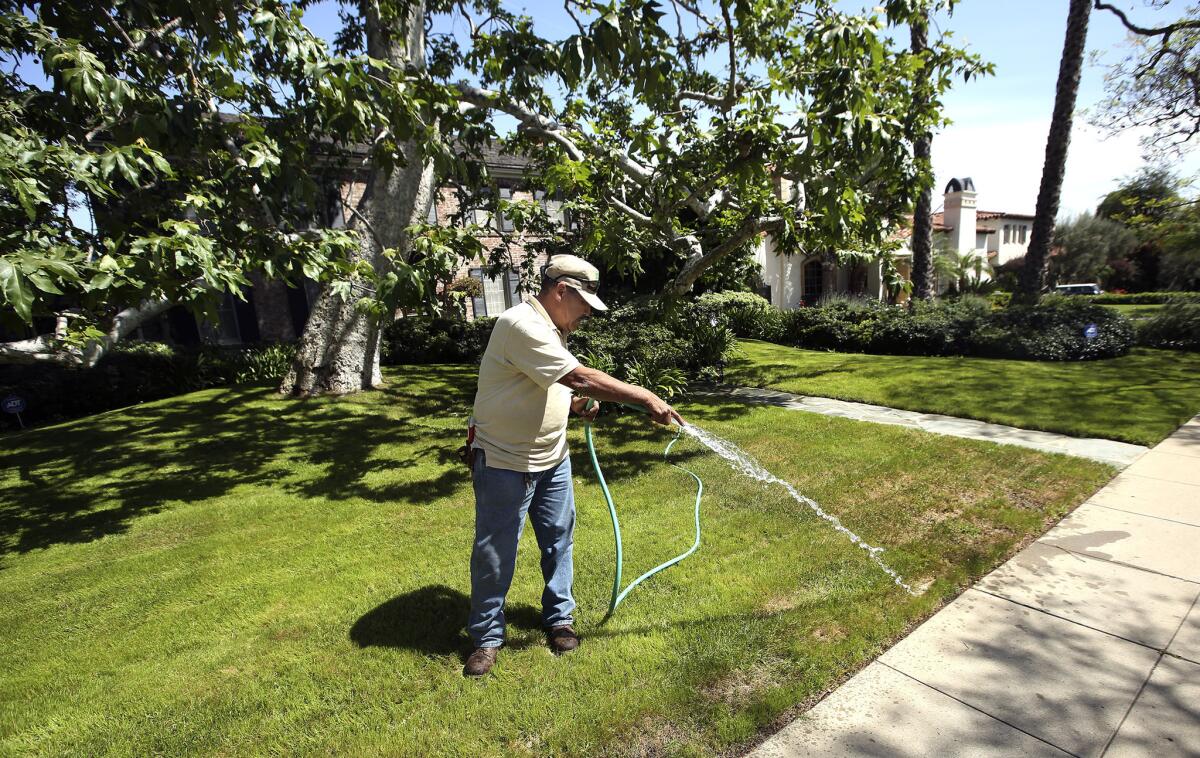Californians cut water usage by 27% in June, but officials remain wary

Landscaper Miguel Herrera waters the front lawn of a home in Beverly Hills on April 3, 2014.
- Share via
Despite record heat, drought-conscious Californians managed to slash urban water use by 27% in June and demonstrated once again that they were on track to meet Gov. Jerry Brown’s historic 25% conservation order, state water officials said Thursday.
Data released by the State Water Resources Control Board showed that Californians had reduced their water consumption by 59 billion gallons compared with June 2013, indicating what officials called a fundamental change in water-use habits.
At the same time, 16 water suppliers missed their conservation targets by 15 or more percentage points and will be contacted by water officials for an explanation, as well as corrective actions, within the next two weeks, officials said.
As of yet, no water suppliers have been fined.
Although the board’s chairwoman, Felicia Marcus, commended Californians on their conservation, she said she worried that residents might ease up on their efforts in anticipation of a potentially drenching El Niño season.
“It’s not that I hate El Niño, I hate El Niño hype,” Marcus said. “It’s Russian roulette.... If it happens we’ll celebrate, but we can’t count on it.”
June was the first month for which urban water districts were required to meet mandated reduction targets, which vary among water agencies depending on past conservation efforts. Suppliers with a history of heavy use have been ordered to slash consumption by as much as 36%, while other districts must reduce use by as little as 4%.
Suppliers that repeatedly fail to meet their savings targets could face fines of as much as $10,000 a day.
“We are taking very serious the scofflaws,” Marcus said. “We will be in their face.... We are deadly serious about this.”
The June savings figures represent a slight decline from May, when water usage dropped by 29%.
Nearly 40% of the state’s 411 urban water suppliers reduced consumption by 30% or more, according to Max Gomberg, the water board’s climate and conservation manager.
Among the water suppliers with the largest savings were the Antelope Valley Waterworks District, with a 42% reduction; the San Gabriel Valley Water Co., with a 35% reduction; and the Yorba Linda Water District, with a 38% reduction.
The Los Angeles Department of Water and Power missed its 16% reduction target by half a percentage point, according to the water board’s data.
The 16 worst-performing water districts included the city of Livingston, which missed its target by almost 29 percentage points; El Monte, which missed its target by more than 22 percentage points; and the Coachella Valley Water District, which missed its target by 15 percentage points.
“It’s a small group, but they’re significantly off the mark and we need to get them back on track,” Gomberg said. “We are going to be meeting with them, and our intent is to develop enforceable orders.”
El Monte Mayor Andre Quintero said the city hopes to hire a consultant who can help its water management, but the City Council has been slow to acknowledge the problem. Twice, he said, the council has failed to pass a measure that would limit lawn irrigation to twice a week.
“It’s absolutely frustrating,” Quintero said. “I don’t know if my colleagues fully understand how serious the issue is.... This is not something you can delay or just hope that El Niño will solve.”
Other districts questioned the accuracy of the data.
At the Fallbrook Public Utility District in San Diego County, which according to state data missed its target by 27 percentage points, officials said some water used for agriculture may have been mistakenly calculated as residential use.
“It’s very confusing, it’s very frustrating,” district spokeswoman Noelle Denke said. “Fallbrook is a very conscientious community. We’re very dedicated and very conscious of the drought.”
An additional 71 water suppliers missed their savings target by 5 to 15 percentage points, officials said.
Experts said the new data are promising, but there is still room for improvement.
“We’ve known for quite some time that this is a serious issue that everybody needs to do their part to conserve,” said Sara Aminzadeh, executive director of California Coastkeeper Alliance. And to see there are people who “are still using two, three, four times the amount that an average Californian uses, I’m seeing real disconnect there.”
Despite calls for conservation, some water agencies remained “openly indifferent or apathetic to the drought regulations and to the drought generally,” she said.
On average, half of all urban water use occurs outdoors. Since April, when Brown ordered the reductions, officials have urged residents to take shorter showers, cut down on car washing and allow their lawns to turn “golden brown.”
Although Marcus said it was clear many Californians were heeding the call, she said it was also important that people try to preserve trees.
Marcus said that trees help reduce heat by providing shade and limiting the so-called urban heat island effect and noted that during Australia’s severe drought, the city of Melbourne had made it a point to double its number of trees.
“Trees are important,” Marcus said. “We don’t need to lose them if we act early and water them.”
Twitter: @montemorin, @rosannaxia
Times staff writer Matt Stevens contributed to this report.
ALSO:
El Niño pushing high temps, rain into California in coming days
Sen. Dianne Feinstein introduces $1.3-billion drought-relief bill
Devastating floods might be more common than we thought
More to Read
Sign up for Essential California
The most important California stories and recommendations in your inbox every morning.
You may occasionally receive promotional content from the Los Angeles Times.












